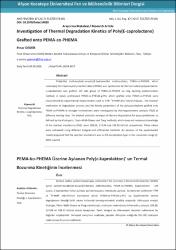| dc.contributor.author | DEMİR, Pınar | |
| dc.date.accessioned | 2017-10-05T08:24:20Z | |
| dc.date.available | 2017-10-05T08:24:20Z | |
| dc.date.issued | 2017 | |
| dc.identifier.issn | 2149-3367 | |
| dc.identifier.uri | http://fenbildergi.aku.edu.tr/wp-content/uploads/2017/04/01120273-85.pdf | |
| dc.identifier.uri | http://hdl.handle.net/11630/4588 | |
| dc.description.abstract | Poly(ethyl methacrylate)-co-poly(2-hydroxyethyl methacrylate), PEMA-co-PHEMA, which
containing 5% 2-hydroxyethyl methacrylate (HEMA) was synthesized by the free radical polymerization.
ɛ-caprolactone was grafted -OH side group of PEMA-co-PHEMA via ring opening polymerization
method. A newly synthesized PEMA-co-PHEMA-g-PCL which grafted onto PEMA-co-PHEMA were
characterized by experimental measurements such as FTIR, 1
H NMR and TGA techniques. The reaction
mechanism of degradation process and the kinetic parameters of the polycaprolactone grafted onto
PEMA-co-PHEMA in nitrogen environment were investigated by thermogravimetric analysis (TGA) at
different heating rates. The evident activation energies of thermal degradation for polycaprolactone, as
defined by the Kissinger’s, Flynn–Wall–Ozawa and Tang methods, which does not necessary knowledge
of the reaction mechanism (RM), were 108.58, 113.88 and 108.35 kJ/mol, respectively. These values
were compared using different integral and differential methods. An analysis of the experimental
results proposed that the reaction mechanism was an R3 deceleration type in the conversion range (2-
40%) studied. | en_US |
| dc.description.abstract | Serbest radikal polimerizasyonuyla sentezlenen %5 oranında 2-hidroksietilmetakrilat (HEMA)
içeren poli(etilmetakrilat)-ko-poli(2-hidroksi etilmetakrilat), PEMA-ko-PHEMA, kopolimerinin –OH
ucuna, Ɛ-kaprolakton halka açılması polimerizasyonu metoduyla aşılandı. Sentezlenen polimerler FTIR
ve
1
H-NMR teknikleriyle karakterize edildi. PEMA-ko-PHEMA-a-PCL aşı kopolimerinin termal
degradasyon kinetiği farklı ısıtma hızlarında termogravimetrik analizle araştırıldı. Aktivasyon enerjisi
Kissinger, Flynn–Wall–Ozawa ve Tang metotlarıyla, reaksiyon mekanizması bilinmeden, sırasıyla 108.58,
113.88 ve 108.35 kJ/mol olarak hesaplandı. Farklı integral ve diferansiyel metotlar kullanılarak bu
değerler karşılaştırıldı. Deneysel sonuçların analiziyle, çalışılan dönüşüm aralığında (%2-40) reaksiyon
mekanizması R3 olarak belirlendi. | en_US |
| dc.language.iso | eng | en_US |
| dc.publisher | Afyon Kocatepe Üniversitesi, Fen ve Mühendislik Bilimleri Dergisi | en_US |
| dc.identifier.doi | 10.5578/fmbd.54020 | en_US |
| dc.rights | info:eu-repo/semantics/openAccess | en_US |
| dc.subject | Thermal Degradation Kinetic | en_US |
| dc.subject | ɛ-caprolactone | en_US |
| dc.subject | TGA | en_US |
| dc.title | Investigation of Thermal Degradation Kinetics of Poly(Ɛ-caprolactone) Grafted onto PEMA-co-PHEMA | en_US |
| dc.title.alternative | PEMA-ko-PHEMA Üzerine Aşılanan Poly(ɛ-kaprolakton)’ un Termal Bozunma Kinetiğinin İncelenmesi | en_US |
| dc.type | article | en_US |
| dc.relation.journal | Fen ve Mühendislik Bilimleri Dergisi | en_US |
| dc.department | Fırat Üniversitesi EOSB Maden Meslek Yüksekokulu Kimya ve Kimyasal İşleme Teknolojileri Bölümü | en_US |
| dc.identifier.volume | 17 | en_US |
| dc.identifier.startpage | 73 | en_US |
| dc.identifier.endpage | 85 | en_US |
| dc.identifier.issue | 1 | en_US |
| dc.relation.publicationcategory | Makale - Ulusal Hakemli Dergi - Kurum Yayını | en_US |



















